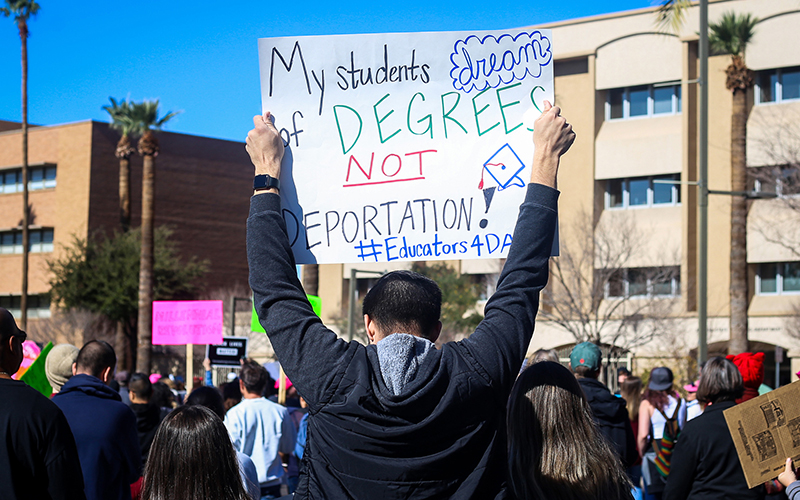
The Public Service Loan Forgiveness program was created in 2007 to let college students who went into public-service careers, like teaching, nursing or the military, apply to have some of their student debt forgiven. But in the first year loans could be forgiven, more than 99.6% of applications were rejected. (Photo by JECO/Creative Commons)
WASHINGTON – The federal government promised college students in 2007 that if they took their degrees and went into a public service profession, they could apply to have whatever student loan debts they still had after 10 years forgiven.
So far, the reality has been somewhat different.
When the first 29,000 applications were filed with the Department of Education last year, just 96 were OK’d, an approval rate of 0.33 percent.
And while the students who looked to the program for help over the last 10 years will have a chance to apply again for loan relief, the Trump administration budget for fiscal 2020 would tighten restrictions on the Public Service Loan Forgiveness plan.
The proposed changes would raise the amount that has to be repaid before the government will consider forgiveness, and would base participation on income, not occupation.
Those changes are not likely to go over well with the teachers, nurses, soldiers and others the act was designed to help, said Cheye-Ann Corona, senior policy associate at the Center for Responsible Lending.
“If you’re already struggling to repay with your income-driven repayment plan, then this would only increase the amount that you would pay,” she said of administration’s proposed changes.
Advocates give the administration plan – and a Senate bill aimed at countering it – little chance of passage. The more pressing concern, they said, is the seeming collapse of a program that public service workers may have been banking on – literally – for the past decade.
“Who this really impacts or has been impacting is folks like teachers or social workers or, you know, folks that are not getting $100,000 a year,” Corona said.
Under the 2007 law, students who hoped to benefit from the PSLF program had to make at least 120 payments of around 9% of their income before they could apply to have the rest of their loan forgiven.
-Cronkite News video by Alyssa Klink
But when the first borrowers filed the paperwork in 2017, their applications were rejected the following year more than 99 percent of the time.
The Arizona Board of Regents said it could not provide the number of students from state schools who were affected by the program’s stumbling start, since the applications for relief are between the applicant and the Federal Student Aid Office. That office said it is not allowed to release state-by-state information.
Betsy Mayotte, the president of the Institute of Student Loan Advisors, said the rejection rate may not be as bad as it sounds. She said there may have been a lot of denials last year simply because people “were not necessarily aware of the rules required for the program” the first time out.
“If we’re still seeing denial numbers this high in 2021-2022, then I’ll start to worry, but right now I’m not particularly concerned,” Mayotte said.
Mayotte said another reason the forgiveness number is so low may be due to the fact that a number of regulations governing the PSLF did not even go into effect until 2011 or later.
“Most borrowers shouldn’t be eligible for forgiveness at this point,” she said.
About 70% of the applications that were filed in 2017 were denied for failing to meet program requirements. The Federal Student Aid Office estimated that another 28% of applications were denied because forms had incorrect or missing information.
Corona said the blame should not be laid entirely at the feet of the applicants themselves.
“Ultimately, the fault, I would say, lies with the Department of Education for not putting out correct guidelines and not incentivizing (loan) servicers to do their job in counseling borrowers,” she said.
That was echoed by Nancy Conneely at AccessLex, a nonprofit dedicated to improving affordability for law students. She called the rejection rate unacceptable.
“The approval rates being so low is alarming,” Conneely said. “I think that speaks to the need by the Department of Education and loan servicers to provide better information to the borrowers.”
Congress stepped in last year and approved $700 million to fund the Temporary Extended PSLF program in fiscal 2018 and 2019. The extension gives people who filled out their forms incorrectly or who were misled by their loan providers another chance to file. The extension program is capped at $350 million a year, which will be distributed on a first-come, first-served basis.
But Corona said the extension program would not be needed if the department did its job in the first place.
“There’s been a lack of oversight from the Department of Education on the Public Service Loan Forgiveness program,” she said.
The uproar over the program comes as the administration is looking to do away with it and combine it and four other income-driven student loan repayment plans into one new plan that it says would save $207 billion over the next 10 years.
The administration’s plan would raise the amount of a student’s payment from the current 9% to 12.5% of their income, and extend the number of years from 10 to 15 before people could apply to have undergraduate debt forgiven. Graduate student debt could be forgiven after 30 years.
In response, 17 Senate Democrats in April introduced the “What You Can Do For Your Country Act of 2019.” It would allow half of loans to be forgiven after five years, make all federal loans PSLF-eligible and require the Department of Education to provide better application information, among other provisions.
Mayotte thinks the legislation is productive, but has little chance in the Senate.
“I mean, I think if it were to pass it would be wonderful,” she said. “I just don’t think it will.”
